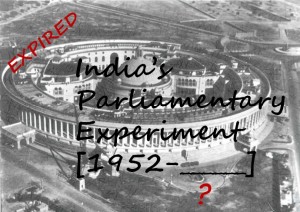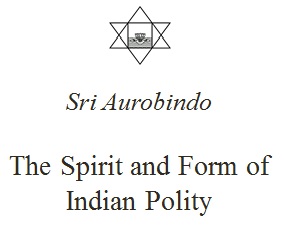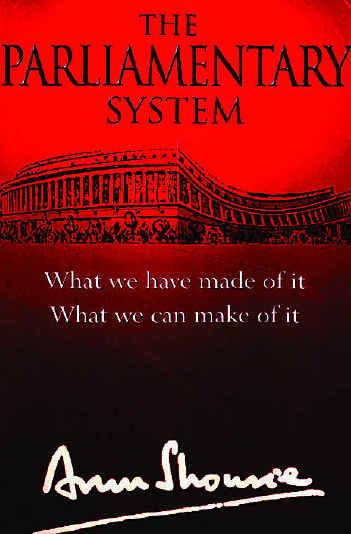
In Part 4, we examined the psychological roots of our modern democratic systems, the idea of representation, and that of a collective ‘reason’. We briefly commented on the inevitable stumbling blocks of such systems in practice. In this article, we take up democracy in the Indian context, with a focus on India’s parliamentary system.
Parliament, and governance of society via the Collective Reason
1. The modern age is essentially an age of Reason. In a rational society every citizen must be given the liberty to develop himself and fulfil his life, satisfy his mental, emotional and vital needs and physical being according to his own desire, governed by his own reason; no other limit to this right and this liberty is to be admitted except the obligation to respect the same individual liberty and right in others. This was the principle applicable to the individual in his personal life.
2. In the collective life, however, society had to be governed not by an individual, but by a collective Reason. But what body or form could constitute this collective Reason? It was in seeking an answer to this question that the system of parliamentary democracy evolved. In practice, this required a system of representation, and a mechanism for citizens to periodically and freely elect their representatives.
3. Thus it was believed that a Parliament with all these elected members becomes not only the representative but also the embodiment of the reason of the people; in other words, a citizen may consider his chosen representative in Parliament as an extension of his own reason. In the words of Sri Aurobindo,
“the enlightened individual could well come to regard this collective reason and will as his own larger mind, will and conscience and find in a happy obedience to it a strong delivery from his own smaller and less rational self.” 1
From these ideas of representation, the Parliament thus came to be seen as supreme and it was a given that the Parliament alone ought to make laws for the country, as it represents the enlightened reason and will of the people.
The Parliamentary system in India
Let us now see the essential elements upon which the Parliamentary system in India actually functions. They are as follows:
- Universal adult franchise with eligible voters having the option to vote or not to vote, as voting is not compulsory.
- Periodic elections are held at different levels: Parliament, State, districts, taluks / tehsils and at the very grass roots” – at village councils or gram panchayats.
- Single-member constituencies or districts, with the first past-the-post winners (also called plurality voting, used in the US, Canada, UK..)
- The Government is formed by the party or the conglomerate of parties that gets a majority of seats in the legislature – the Lok Sabha (लोक सभा / Lower House)
- The leader elected by the elected members of that party or conglomerate of parties is nominated as the Prime Minister.
- The Prime Minister (PM) selects his ministers only from the legislature, and only from his own party.
- The PM is the head of the government, having appointed the Council of Ministers, having set their department and term, and of whom s/he is the head.
This system is believed to be justified because:
- It is said to be representative of the people and their will.
- It is assumed that the Government formed in this manner will be broad based, representative, stable, durable and effective.
- It claims to ensure accountability – of each member to the Prime Minister, of each minister to his colleagues through the principle of collective responsibility and finally of the Executive to the Parliament.
The established procedures of Parliament
The Parliament is the body that makes the laws for the nation. How do these laws come into being? There are protocols and procedures in place which the Parliament is designed to follow. Briefly, this is the “due process”:
- Bills are introduced by the Executive;
- These are scrutinised by standing committees;
- The reports of standing committees are then studied by the Executive, any changes deemed necessary are then proposed
- The legislature then debates the Bills clause-by-clause
- Finally there is voting for or against them.
Given this “due process”, the established procedure of law-making actually appears to be quite reasonable and sound. Yet, there is so much criticism and dissatisfaction with this system. This dissatisfaction has in its extreme, even denounced parliamentary democracy altogether. But we shall proceed carefully, and observe for ourselves how the Parliament really works.
Does the parliament represent the will of the people?
To see how far this is true, we consider an illustrative example from recent events. In the book The Parliamentary System, Arun Shourie demonstrates how in the 2004 Lok Sabha elections, 59 MPs of Uttar Pradesh entered the Lok Sabha with just 10 to 20 per cent of the vote. While the then Basti MP won on just 11 per cent of the votes, the Robertsganj MP needed 11.4 per cent, Mohanlalgunj MP 11.6 per cent, Mirzapur MP 12.4, Bansgaon MP 12.5 per cent, and so on. It must further be noted that this 11% is of the votes cast and in most elections only 50% of the eligible voters cast their vote. Thus this 11% really comes down to around 5% to 6%. If we glance at the proportion of votes by obtaining which members got elected to the Lok Sabha in 2004, we get the following results. 99% of the members got into the Lok Sabha by getting less than half the electors to vote for them. Almost 60% got in with the endorsement of less than 30% of electors in their constituencies. Even with 100% of eligible voters exercising their vote, the MPs can hardly be said to be representative of the people. In reality, we see quite clearly that the elected members of parliament are not truly representatives of the people. In the State Assemblies, the numbers deteriorate further south, though we will not go down this path anymore. Yet, it is confidently claimed that Parliament represents the people of India.
The Supremacy of the Parliament?
It is being continuously argued by many members of Parliament and some political commentators that it is only Parliament that can make laws; no other individual or group has the right to make laws since it is the sole prerogative of Parliament. Here is what an editorial in the Hindu wrote recently: 2
In appraising what has happened over the past fortnight, a red herring needs to be got out of the way — the idea of the ‘supremacy of Parliament’ versus everyone who comes up against it. Parliamentarians, who assert this, need to learn their Constitution. In India, unlike Britain, Parliament is not supreme; the Constitution is. Nor is law-making “the sole prerogative” of Parliament. The significant victory of the anti-corruption campaigners gives political India a rare opportunity to translate fine anti-corruption sentiments into a potent law that can be a game-changer. The challenge before the people of India is to ensure, by keeping up the pressure that in the tricky business of law making in committee and on the floor of the Houses of Parliament a potentially powerful instrument is not blunted.
For in India the situation is different from that prevailing in Britain. Britain does not have a written Constitution and quite naturally Parliament is supreme. It suits their natural genius and has been working for more than a century. But in India we have a written constitution which has been amended by Parliament several times. It is therefore absurdly argued that Parliament is supreme. But it must be remembered that the Constitution is for the people.
It would be therefore more correct to say that the people are supreme and that both the Constitution and Parliament are meant to be the expression of the people and their will. Thus neither the Constitution nor Parliament can be considered as a sacred cow which one must not touch. What needs to be done is to make both the Constitution and Parliament more responsive and representative of the people of India. For after all, the Constitution has been made for the people of India and it must represent the genius and temperament of the history and aspirations of the Indian people. It follows that members of Parliament must be well versed with the history and deeper psychological aspiration of the people of India down the ages. Consequently the people must be consulted in major changes to the Constitution. All radical alterations must get the assent of the people of India and that can be done by a referendum. Only then will we be moving towards a more democratic democracy.
In his essays on Indian polity, Sri Aurobindo commented on the supremacy of the people or praja 3
India always had the democratic idea, applied it in the village, in council and municipality, within the caste, was the first to assert a divinity in the people and could cry to the monarch at the height of his power, “O king, what art thou but the head servant of the demos?”
- Is the Parliament actually applying the collective reason to make laws for the country?
- How are decisions actually taken?
- What is the quality of our Parliamentarians?
- Who, if at all, is the Executive accountable to?
(series edited by Uday Arya)
Other articles in this series
Part 1 | Part 2 | Part 3 | Part 4 | Part 5 | Part 6 | Part 7
“All political ideals must have relation to the temperament and past history of the race.” – Sri Aurobindo
Notes







